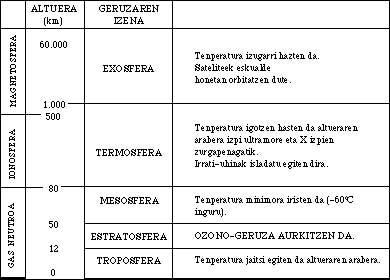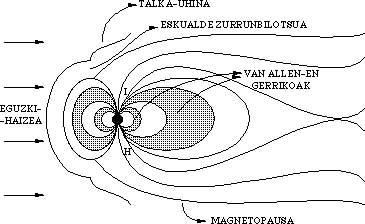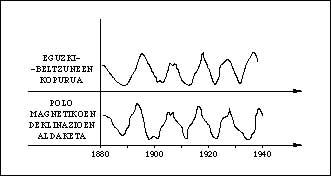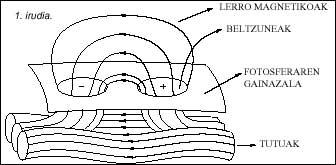Influence of solar activity on soil (I)
1989/07/01 Arregi Bengoa, Jesus Iturria: Elhuyar aldizkaria
Although most of the energy we receive from the Sun comes to us as electromagnetic radiation, its fractional emission is not negligible. In addition to the neutrals produced by thermonuclear reactions that occur in the nucleus, there are many choral fractions that can escape the influence of the solar gravitational field: protons (hydrogen nuclei), electron, <unk> fractions (helium nuclei) and neutrons. This emission extends through the Solar System and is called “solar wind”.
This flow is, of course, sustainable, but, as we have seen in the previous issues of the magazine, it increases noticeably due to the phenomena of the activity of the Sun, and through it we arrive most of the effects of this activity. The density generated by the solar wind around the Earth is about 10 fractions/cm3. The loss of solar material is estimated at around 106 tons/second, although by 6x1013 the Sun would be a life a thousand times predicted according to the processes that determine its evolution. Fractions are normally launched at a speed of between 200 and 900 km/s, but at peak times they reach speeds of up to several thousand kilometers per second.
The Earth is not without protection against fractions and violent radiation. Several layers protect in the atmosphere. However, in this case, when talking about the atmosphere, we are not only referring to the denser gas layers that we have closest to the earth's surface, that is, to the gases that the gravity field maintains around the Earth, but to all those that are up to the magnetopause. The magnetopause, in particular, is the limit of the magnetosphere, that is, the region in which the Earth's magnetic field has sufficient force so that the fraction (especially the ions) can be affected by it.
The magnetosphere and ionosphere are the most important of the protective layers. Figure 1 shows an outline of the structure of the atmosphere to clarify the ideas. On the left side we have layers that can be differentiated taking into account the interaction of matter with the solar wind. To the right we have the normal division. The data given in it as height of the magnetosphere is orientative. In reality, the shape of the region affected by the Earth's magnetic field is deformed by the solar wind, as can be seen in Figure 2.

In the area towards the Sun the magnetic lines narrow due to their impulse, generating shock waves and turbulent transition regions. At the back, the field does not support compression and when the magnetic force of the Earth weakens enough, the fractions loaded with solar wind drag the magnetic lines with narration to its break. These are associated with the lines of the interplanetary zone, defining the magnetopause. The tail seen in the image can go further than the Moon.
In this first article we will talk about the phenomena that occur in the two layers mentioned above and in the following we will expose the consequences that are observed on the earth's surface, such as climate. The most representative case for analyzing the effects of solar activity is that of the eruptions. Once one of them is produced, in addition to generating the emission of strong electromagnetic waves, two contributions are produced that intensify the solar wind. The first, the fractions of higher speed (arriving about an hour after the eruption) and the second, formed by slower fractions (but denser, arriving several hours or some day later). Let us first analyze the influence of eruptions on the ionosphere.
The ionosphere is a plasma layer between 80 and 500 km. The main responsible for the ionization of atoms between these limits is solar radiation. Therefore, the concentration of positive electrons and ions depends on factors such as the hours of the day, the season of the year, the state of the solar cycle, etc. In its structure you can distinguish layers D (between 90 and 100 km), E (between 100 and 140 km) and F (between 140 and 500 km) depending on its composition, density, ionization process and degree of recombination. Although layer D is slightly ionized during the day, at night the recombination is total.
Below this layer the gas is always neutral and above layer F we never find neutral gas. The different layers of the ionosphere serve, for their properties, to reflect radio transmissions at great distances. When the sine of the wave incidence angle with the reflective layer matches the refractive index between the layers, a total wave reflection occurs. However, when eruptions occur, ultraviolet, X-rays and stronger rays come much more, which modifies reflection on the radio waves of the layers and absorption properties.

Because the causes of these effects are electromagnetic emissions, the effects begin to be noticed at 8.5 minutes after the phenomenon occurs. For example, small waves reflected in layers E and F under normal conditions are lost in layer D by absorption in the new state, resulting in the so-called SWF effect. On the other hand, the layer D itself is reflective of long waves and with ionization conditions are significantly improved, causing an “increase in the escape of signals” (SES).
These phenomena and others that may arise are called “ionospheric bapat disturbances” (SID) and can form for a few hours large radio emissions, such as those used in navigation, aircraft, radar systems, etc. On the contrary, they can also offer the possibility of receiving remote television signals. In addition, the infrared emission that comes directly from the Sun can produce very resistant interference in the aforementioned cases and in the reception of satellite communications.
In addition to these ionization phenomena, in moments of high activity the expansion of the lower layers of the Earth's atmosphere is appreciated. Consequently, spaces located in low orbits suffer the effects of increased friction, even falling (as happened with the well-known Skylab). As for the spaces, it is also important to push the simple permanent solar wind, especially if they are large and light. For example, Echo I deviated markedly from the orbit calculated by this push. But, once again, in line with the influence of eruptions, let us study the effects of the two increases mentioned by the solar wind.
The first emission is mainly composed of relativistic protons that when they meet the higher layers of the atmosphere create nuclear disintegrations. The products of these reactions can be detected on Earth, producing the so-called surface effect (GLE). These high energy protons are very dangerous for astronauts who leave the spaces and force to design protection systems. When moving artificial satellites in the magnetosphere, they have the same problem because of the need to protect certain devices. When the Soviets lost contact with Martitz and, above all, with the second mission of Fobos sent to analyze their satellites, the aforementioned problems were considered as possible causes.
The second emission of fractions is much denser than the first and produces magnetic storms and other disturbances. These are changes in the geo-magnetic field that can last two or three days of storm. In the first place an increase is seen due to the pressure of the fractional wave, but later a jet of fraction of the tail of the magnetosphere is introduced, forming the electric currents in the regions called “Van Allen belts”. These currents mean a decrease in the area that is gradually normalizing. Van Allen belts are two regions of the magnetosphere where fractions are confined. The first is formed by protons and is located 4,000 km from the land surface. The second one is about 24,000 km high and captures electrons (see figure 2).

However, the geomagnetic field has two weak regions compared to the bombardment of fractions: the two poles. As is known, the force of magnetic fields is the maximum of fractions when they enter perpendicularly to the field. Therefore, those who reach the poles (either directly or well diverted by the magnetosphere itself) find a very small drawback and reach Earth. On the way, between 1000 and 100 km high, allow you to ionize the atoms of oxygen and nitrogen, giving rise to emissions of red and green colors, that is, forming red knives. These magnetic poles can be seen in regions of about 23º (note that the magnetic poles are deviated 11º from the geographic ones).
We have already analyzed some effects, all related to the Earth's magnetic field. It is logical, therefore, that these interactions may have some impact on this geomagnetic field. Although the causes are not well known, Figure 3 shows the close relationship between the activity of the Sun and the change of position of the magnetic pole.
In the following issue, we will take care of the effects observed on the Earth's surface. Let's take another step in studying the influence of the Sun on our planet.


Gai honi buruzko eduki gehiago
Elhuyarrek garatutako teknologia





